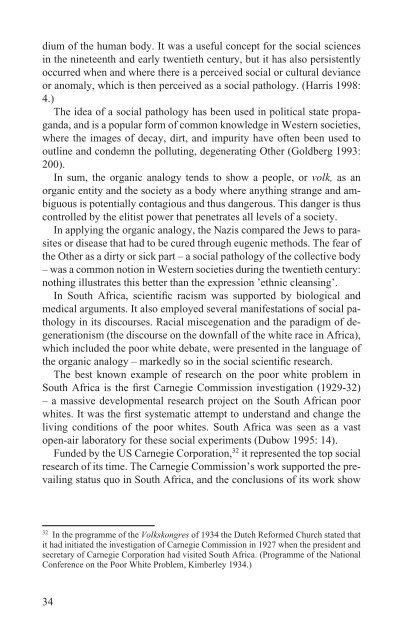The Making of a Good White - E-thesis - Helsinki.fi
The Making of a Good White - E-thesis - Helsinki.fi
The Making of a Good White - E-thesis - Helsinki.fi
Create successful ePaper yourself
Turn your PDF publications into a flip-book with our unique Google optimized e-Paper software.
dium <strong>of</strong> the human body. It was a useful concept for the social sciences<br />
in the nineteenth and early twentieth century, but it has also persistently<br />
occurred when and where there is a perceived social or cultural deviance<br />
or anomaly, which is then perceived as a social pathology. (Harris 1998:<br />
4.)<br />
<strong>The</strong> idea <strong>of</strong> a social pathology has been used in political state propaganda,<br />
and is a popular form <strong>of</strong> common knowledge in Western societies,<br />
where the images <strong>of</strong> decay, dirt, and impurity have <strong>of</strong>ten been used to<br />
outline and condemn the polluting, degenerating Other (Goldberg 1993:<br />
200).<br />
In sum, the organic analogy tends to show a people, or volk, as an<br />
organic entity and the society as a body where anything strange and ambiguous<br />
is potentially contagious and thus dangerous. This danger is thus<br />
controlled by the elitist power that penetrates all levels <strong>of</strong> a society.<br />
In applying the organic analogy, the Nazis compared the Jews to parasites<br />
or disease that had to be cured through eugenic methods. <strong>The</strong> fear <strong>of</strong><br />
the Other as a dirty or sick part – a social pathology <strong>of</strong> the collective body<br />
– was a common notion in Western societies during the twentieth century:<br />
nothing illustrates this better than the expression ’ethnic cleansing’.<br />
In South Africa, scienti<strong>fi</strong>c racism was supported by biological and<br />
medical arguments. It also employed several manifestations <strong>of</strong> social pathology<br />
in its discourses. Racial miscegenation and the paradigm <strong>of</strong> degenerationism<br />
(the discourse on the downfall <strong>of</strong> the white race in Africa),<br />
which included the poor white debate, were presented in the language <strong>of</strong><br />
the organic analogy – markedly so in the social scienti<strong>fi</strong>c research.<br />
<strong>The</strong> best known example <strong>of</strong> research on the poor white problem in<br />
South Africa is the <strong>fi</strong>rst Carnegie Commission investigation (1929-32)<br />
– a massive developmental research project on the South African poor<br />
whites. It was the <strong>fi</strong>rst systematic attempt to understand and change the<br />
living conditions <strong>of</strong> the poor whites. South Africa was seen as a vast<br />
open-air laboratory for these social experiments (Dubow 1995: 14).<br />
Funded by the US Carnegie Corporation, 32 it represented the top social<br />
research <strong>of</strong> its time. <strong>The</strong> Carnegie Commission’s work supported the prevailing<br />
status quo in South Africa, and the conclusions <strong>of</strong> its work show<br />
32<br />
In the programme <strong>of</strong> the Volkskongres <strong>of</strong> 1934 the Dutch Reformed Church stated that<br />
it had initiated the investigation <strong>of</strong> Carnegie Commission in 1927 when the president and<br />
secretary <strong>of</strong> Carnegie Corporation had visited South Africa. (Programme <strong>of</strong> the National<br />
Conference on the Poor <strong>White</strong> Problem, Kimberley 1934.)<br />
34
















